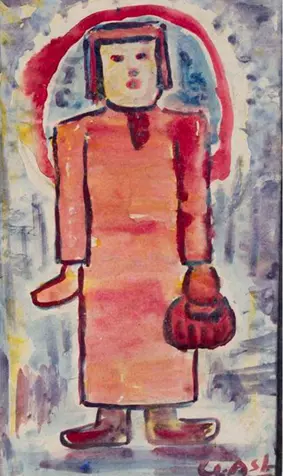Prinseps Launched the First NFT Auction in India This January, Featuring Works by Gobardhan Ash
Prinseps, a Mumbai-based auction house, showcased artworks by Indian artist Gobardhan Ash during the first-ever NFT auction in India. The sale included 35 rare works of art on paper by the artist alongside 35 matching NFTs. The auction attempted to replicate the 1950 second exhibition of the Progressive Artists’ Group and the Calcutta Group, where Ash shared the stage with the likes of M. F. Husain, F. N. Souza, and S. H. Raza.
The white glove auction boasted a 100% sell-through rate and hammer prices well above the high presale estimates. While bidders favored the physical works of art, most of the available NFTs sold for INR 15,000 (USD 200) or more.

Primarily documenting modern-day objects and people, Ash’s works have been revered for their lifelike details. The artist used intricate character studies and modernist interpretations of a subject’s life to transform the mundane into meaningful juxtapositions. To mark the first-ever NFT auction in India, Prinseps curated works that resembled internet avatars or profile pictures.
All of the 35 physical works on paper offered in the auction had presale estimates ranging from INR 30,000 to ₹50,000 (USD 400 – $675). Immediately following the works on paper were digital versions minted on the Ethereum blockchain with a range of INR 1,000 to ₹25,000 (USD 13 – $340). Most lots sold above their high estimate. The top item was Gobardhan Ash’s Boggy Land from 1950. The physical version sold for INR 1,00,000 (USD 1,350) while the NFT version sold for ₹27,500 ($370). Also notable was the paper version of Prayer, which Ash executed in 1948 (INR 1,00,000 / USD 1,350).

Other featured items in the auction included Fa-Hi-An, which portrays a Chinese Buddhist monk who traveled by foot from China to India with the sole purpose of studying Buddhist texts. In the painting, the man dressed in red stands against a gray backdrop. The physical version sold for INR 56,250 (USD 760). The live sale also offered a piece titled Mosgul, which roughly translates to a man lost in thought. The artist employed broad brushstrokes and a muted palette in the piece. The paper version achieved INR 62,500 (USD 840). All of the above items were previously showcased in the joint exhibition of the Calcutta Group and the Progressive Artists’ Group in 1950.
“If we look at nature in the open, we do not see individual objects each with its own colors but rather a bright medley of tints which blend in our eyes, in our minds,” said Gobardhan Ash about his artworks. Ash’s journey of becoming a pioneer of modern Indian art began in 1926 at the Fine Arts Government School of Arts in Kolkata. Many identify his avid passion for painting with his attention to detail. Mostly depicting Western modernism in India, his artworks are often interpreted as being bold, free of any boundaries, and visionary.
With the end of the Gobardhan Ash Avatars auction, Prinseps plans to host a no-reserve Nationalism Book Auction in late January. The offered collection consists of rare and first edition books ranging from pre-independence to post-independence periods in India. The books are mostly written and signed by influential figures such as Mahatma Gandhi, Jawaharlal Nehru, and V. K. Krishna Menon.
Explore the complete results from the first NFT auction in India by visiting Prinseps’ website.
Auction Daily presents the latest news from the art and auction worlds. Check out our timeline tracking the rise of NFTs in 2021.









